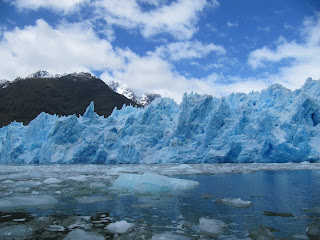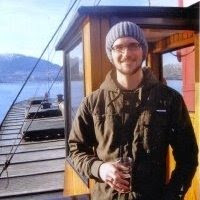We set off for the mountain at six in the morning in an old landcruiser; myself, two other backpackers from Ireland and Canada respectively and our two guides. Two hours of bumpy gravel later we arrived at the end of the road and geared up for the hike up from the carpark to the climbing refuge, at 4800m. I had brought along around 8 litres of water and with that in my pack along with all the other gear and food for the next two days I was carrying at least 20kg, and on steep, soft scree at 4500m I was really feeling it. The other guys were streaking ahead and when I finally got to the top I was getting a little worried about my fitness levels, until I felt the other guys bags and they were less than half the weight of mine. Apparently we were going to be supplied with water at the refuge, nice to know.
After setting up our beds in the bunkhouse upstairs (70 people in one room, with bunks stacked three high...) and having a huge and tasty lunch we went up the mountain a few hundred metres to the bottom of a glacier to put on our crampons and practice some ice climbing. We went over the basic walking and rope techniques and practiced braking with the ice axe in case we had a slip in a steep section. After hearing of other climbers' bad experiences (with dodgy tour operators) up here it was good to see that our guides were both very patient and professional and seemed to take safety very seriously. We were also lucky to have two guides for three people, which meant if one person had to turn back the other two could continue with the remaining guide.
Looking up to the summit, doesn't look that far.....

With the refuge in the background

After an early but once again massive and delicious meal for dinner it was off to bed at 8 to hopefully get a bit of sleep before heading off at one in the morning. As a result of the altitude, the constant noise of 70 climbers fumbling around in the dark and the palpable excitement of what would be most peoples first climb noone reported getting any sleep, except for the snoring guy two bunks across who apparently slept like a baby.
With nearly everyone leaving for the summit at either midnight or one it became a bit of a mad scramble to get out on the trail first and with a relatively small group we were lucky enough to get out first of the 1am group, having nothing but the faint, grey glow of the snow fading into the darkness ahead of us.
We started slow and gradually picked up pace as we went along, with the lead guide doing a great job of pacing us so that we stayed within our limits but still made reasonable time. At some points it felt a little too slow but this high up just a couple of quick power steps can leave you gasping for air, and even maintaining the same pace I would feel great and strong on one section and then like I was pushing my limit ten minutes later. Apart from being a bit more puffed than usual I wasn't really feeling the altitude at all, no headache, no nausea and a nice clear mind. The two weeks of sitting around in Quito were paying off! Apparently being a smoker is also an advantage, as your body has adapted to regularly being low on oxygen, nice.
Around halfway up the Canadian guy started to get a bit woozy and threw up a couple of times, which I thought was a bad sign but the guides didn't seem worried, and he kept on going as normal. The route was also more precipitous than I had imagined, as it is considered a non-technical climb I assumed we would just be walking up a smooth slope of snow. In reality it was a lot more interesting, with walls of ice, gullys, big cracks and crevasses and some enormous and oddly shaped icicles. Some parts were also very steep, with the lead guide having to kick the path into the slope, and requiring us to use the axe and hug the side, carefully checking each footing before putting weight on it. As it was dark there were no real views to speak of, other than the murky orange glow of Quito down in the valley far below, and the long winding snake of headlamps gradually working their way up towards us.
A few hundred metres before the summit I was feeling great and overtook the other two who had slowed down slightly and by this stage were looking a little haggard. My guide and I steamed off and were maybe 50 metres ahead when he suggested that we wait for the others to catch up, which took a good five minutes as by now they were going very slowly. They caught and passed us and as we started up behind them and attempted to get back into the rhythm I found I was suddenly very weak and right on my limit. The next forty five minutes were a real struggle as countless times we approached what appeared to be the top only to find that there was yet another rise on the other side. I knew we were very close and each time I convinced my body that this surely must be the final desperate push, but as we crested the horizon and I prepared to flop down limply in the snow my heart sank time and time again.
At last, and as I was on the verge of finally calling a stop before I crumpled in a heap the slope opened out and started to descend slightly. Looking around I gradually comprehended that there were no other higher points around, this was it, we'd made it!!!
This was as enthusiastic as we could get

The crater

Upon reaching our goal it was hard to know what to feel. All I wanted to do was to lay down and have a good rest but with so little oxygen in the air (less than half the amount that there is at sea level) this was next to impossible. It didn't really feel like reaching the end of anything at all ( and it wasn't really, we still had to get back down which is just as dangerous as climbing up) so I guess in a funny way the real summit was the biggest false summit of all! There were thick clouds in all directions down below us blocking everything from sight too which was a little disappointing but peering down into the steaming crater was nice, and it really did feel like we were on top of the world.
After taking the obligatory triumphant photos and having a swig of some nasty cooking brandy (?!?) that someone had brought along for the celebrations we thankfully started back down by the same track that we had come up on, and a lot faster than you would think. Yet another funny thing I noticed about altitude is that while it is ridiculously hard to go uphill, on the flat and going down feels only slightly more difficult than at sea level.

Despite being more than a bit stuffed and myself getting along by more of a controlled stagger than a walk we made it down more than half way before we needed a break. We stopped off for ten minutes and then continued down quite uneventfully, taking it easy and getting a few snaps on the way, as we could now actually see what was around us.



It had taken us 4 hours 50 min to get to the summit from the refuge which was a pretty good time for inexperienced climbers ( usual time is between 5 and 6 hours) but a hell of a long way off the record of 1 hr 30! ( our guide had once done it in 1:50, alone and with minimal equipment to save weight)
The whole trip (two days with all food, gear, transport and accomodation) cost 170 dollars, which is a bargain really and a fraction of what you'd pay in a western country. The company I went with (CarpeDM Adventures) were very professional and with great gear and food and I'm currently making plans to return to Ecuador to climb Chimborazo (6300m) with them early next year :)


















 The left side
The left side





 In Ushuaia we spent a couple of days walking around checking out the "end of the world", catching up on laundry, shopping and going on a small train trip through the national park to the site of a former prison camp noted for its brutal conditions.
In Ushuaia we spent a couple of days walking around checking out the "end of the world", catching up on laundry, shopping and going on a small train trip through the national park to the site of a former prison camp noted for its brutal conditions.









 We spent a good forty five minutes cruising around through the ice, listening to the creaking and groaning of the glacier and looking out for the occaisional big chunk falling off the face and crashing into the sea. As we first approached a particularly big chunk broke off and actually caused a decent sized wave to come roaring towards us, glad we weren't closer when that one fell....
We spent a good forty five minutes cruising around through the ice, listening to the creaking and groaning of the glacier and looking out for the occaisional big chunk falling off the face and crashing into the sea. As we first approached a particularly big chunk broke off and actually caused a decent sized wave to come roaring towards us, glad we weren't closer when that one fell....






 This was backed up a day later with another two buses down to the Chilean border and finally Santiago, a trip of over 55 hours and 3500km, but on big comfortable buses it wasn't that bad really.
This was backed up a day later with another two buses down to the Chilean border and finally Santiago, a trip of over 55 hours and 3500km, but on big comfortable buses it wasn't that bad really.










